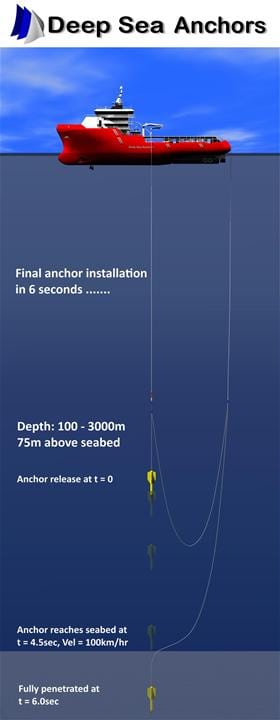Principles of Concept
The DPA™ is released freely from a predetermined height over the seabed in which gravity is used as the installation force. A 75ton DPA™ for example, dropped from a height of say 50 to 75 meters, will acquire a velocity of ca. 25-30 m/sec when it reaches the seafloor. At such velocities, deep penetrations are obtainable into stiffer lower lying seabed sediments depending on their strength and deformation characteristics.
The DPA™ concept is built on the following principles:
- Very large kinetic energy made available through freefall, which «shoots» the anchor into the seabed. No external energy source is therefore required e.g. no proof loading necessary.
- Optimum fluid dynamic design to achieve a high freefall velocity and non-rotational stability.
- The anchor design takes advantage of the fact that most deep-water soil sediments have significantly reduced undrained shear strength in a remolded state (during penetration) than after consolidation is complete i.e. when excess pore water pressure has dissipated.
Due to the anchor’s low cross-section area, hydrodynamic forces are limited when lowering through the splash zone and water column and therefore installation is not as weather sensitive as other anchor types may be.
In comparison to alternative solutions, DPA™ offers the following advantages:
- No external energy required for installation
- Greater weather window than comparable suction anchors solutions
- No orientation requirements, i.e. can be loaded in any direction
- Precise horizontal positioning
- Quick installation
- Applicable for taut leg mooring
- Low sensitivity to increasing water depth
- No restriction regarding water depth, i.e. no electrical cables, pump skids, etc.
- No proof loading required
- Only one failure mode to analyze
- More cost-effective with respect to fabrication and marine operations than comparable alternative solutions

